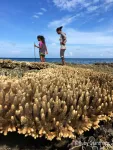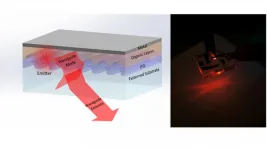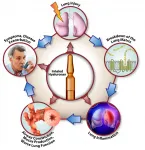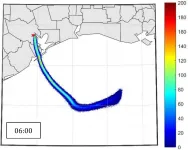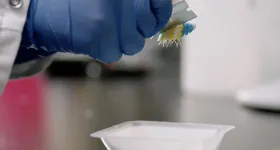(Press-News.org) Scientists say stable seafood consumption amongst the world's poorer coastal communities is linked to how local habitat characteristics influence fishing at different times of the year.
In the coastal communities of low-income countries, the seafood people catch themselves is often a main food source. In a new study, scientists focused on an often-overlooked type of fishing called gleaning: collecting molluscs, crabs, octopus and reef fish by hand close to shore.
"We surveyed 131 households in eight coastal communities on a small island off Timor-Leste," said study lead author Ruby Grantham from the ARC Centre of Excellence for Coral Reef Studies.
Grantham said even though gleaning is important for food security in rough weather--when other types of fishing often aren't possible--some households don't do it.
"It's not just a case of people fishing when they need to. Weather and coastal conditions make fishing activities, including gleaning, dangerous, unsuccessful or even impossible in some places at certain times of the year," Grantham said.
She said the findings illustrate the ways people interact with, and benefit from, coastal ecosystems. And how this varies between communities and seasons.
The study found the ability of households to glean in rough weather was influenced by the total area and type of shallow habitat close to the community.
"This highlights why we need context-specific understanding of dynamic coastal livelihoods and small-scale fisheries in particular," Grantham said.
"Even amongst these eight communities on the same small island we found distinct differences in how and when gleaning contributes to household fishing activities and as a source of subsistence seafood."
Co-author Dr David Mills, Research Leader for the WorldFish Country Program in Timor-Leste, said the research is important for the future management of coastal fisheries.
"In Timor-Leste, low-income households have few opportunities to access the high-quality nutrition available from seafood," Dr Mills said.
"We know that gleaning fisheries are really important for food security at particular times of the year," he said.
"And this detailed research will help us develop management approaches that keep fisheries sustainable while also ensuring seafood remains available to those who need it the most, when they need it the most."
Climate change is altering the world and its environments rapidly. People depend on their interactions with nature for many aspects of wellbeing. Understanding these interactions is critical for diagnosing vulnerabilities and building resilience, especially amongst coastal communities who depend directly on healthy oceans for food.
"The success of coastal livelihood strategies depends on a range of influences that are now, at best, poorly-understood," Grantham said.
"We wanted to explore how people interact with and benefit from coastal environments through time."
Grantham said a better understanding of the existing relationships between people and nature, as well as how these influence interactions between societies and local ecosystems, is crucial to legitimate environmental policy and management to ensure sustainable futures.
"We need to further consider the factors influencing how feasible and how desirable social-ecological interactions, like fishing, are across different seasons," she said.
"These insights of the fine scale dynamics in how people interact with coastal ecosystems through activities such as gleaning can help strengthen our understanding in research, decision-making and management in coastal areas exposed to environmental change."
INFORMATION:
PAPER
Grantham R, Álvarez?Romero J, Mills D, Rojas C, Cumming G. (2021). 'Spatiotemporal determinants of seasonal gleaning'. People and Nature. DOI: 10.1002/pan3.10179
CONTACT
Ruby Grantham (Townsville, Australia)
E: Ruby.Grantham@my.jcu.edu.au
David Mills (Townsville, Australia)
P: +61 (0) 415 067 551
E: D.Mills@cgiar.org
FURTHER INFORMATION
Melissa Lyne / Coral CoE (Sydney, Australia)
P: +61 (0)415 514 328
E: Melissa.Lyne@jcu.edu.au
(Boston)--There have been great advances in treating melanoma over the past five years, however, even with these treatments many patients quickly develop drug resistance and die from their disease. A new study from Boston University School of Medicine (BUSM) has discovered that a drug (YK-4-279) that was previously created to target one specific type of protein has much broader use against a family of proteins that act to promote melanoma.
"We find that this drug inhibited melanoma from becoming more aggressive in human cells and in experimental models. We also found a specific pathway that this drug acts through to be anti-cancer: inhibiting proteins that drive genes that promote cancer cell growth and metastasis," ...
COLUMBUS, Ohio - Antarctic ice is melting, contributing massive amounts of water to the world's seas and causing them to rise - but that melt is not as linear and consistent as scientists previously thought, a new analysis of 20 years' worth of satellite data indicates.
The analysis, built on gravitational field data from a NASA satellite system, shows that Antarctica's ice melts at different rates each year, meaning the models scientists use to predict coming sea level rise might also need adjusting.
"The ice sheet is not changing with a constant rate - it's more complicated than a linear change," said Lei Wang, assistant professor ...
Researchers from North Carolina State University and the University of Texas have developed and demonstrated a new approach for designing photonic devices. The advance allows them to control the direction and polarization of light from thin-film LEDs, paving the way for a new generation of virtual reality (VR) and augmented reality (AR) technologies.
"This is a fundamentally new device architecture for photonic devices," says Franky So, corresponding author of a paper describing the work. "And we've demonstrated that, using our approach, directional and polarized emissions from an organic LED or a perovskite LED without external optical elements can be realized." So is the ...
Researchers at the National Institutes of Health and their collaborators found that inhaling unfragmented hyaluronan improves lung function in patients suffering from severe exacerbation of chronic obstructive pulmonary disease (COPD). Hyaluronan, a sugar secreted by living tissue that acts as a scaffold for cells, is also used in cosmetics as a skin moisturizer and as a nasal spray to moisturize lung airways. Utilized as a treatment, hyaluronan shortened the amount of time COPD patients in intensive care needed breathing support, decreased their number of days in the hospital, and saved money by reducing their hospital stay.
The study, published online in Respiratory Research, is a good example of how examining the impacts of environmental pollution on the lungs can ...
Self-control significantly affects well-being and objective success in life. Although many agree that a high degree of self-control is beneficial, helping people develop more self-control is a tricky challenge. Self-control training, like training in any domain, is affected by the basic question of whether a person is motivated to improve self-control. Recent work has found that people differ as to how strongly they desire better self-control, and reveals some of the factors affecting this desire.
Desire for self-control (DSC) reflects a wish to have an improved self-control ability. This desire is influenced by societal or cultural ...
HOUSTON - (Feb. 1, 2021) - When aboveground storage tanks fail during a storm and their toxic contents spread, the threat to human health can and probably will flow downwind of the immediate area.
Rice University engineers have developed a model to quantify what could happen when a hurricane or other natural disaster causes such damage based on data gathered from the Houston Ship Channel, the largest petrochemical complex in the United States, during and after two hurricanes, Ike in 2008 and Harvey in 2017.
Pollutants like toxic organic chemicals evaporate ...
There is a considerable gap in our current understanding of gift-giving because much of what has been studied has focused on gift-giving as an affair between just two consumers--a single giver and a recipient. Little is known about the impact other gifts have on the recipient of the gifts, even though some of the most common occasions for giving a gift, such as birthdays, the winter holidays, Mothers' and Fathers' Day, graduations, bridal showers, baby showers, bachelor and bachelorette parties, going away parties, and retirement parties, all typically involve a recipient receiving gifts from several different givers.
Researchers from ...
(DENVER--February 1, 2021, 10:00 a.m. EST) The first comprehensive, prospective study of smoking habits in patients with non-small cell lung cancer (NSCLC) who were enrolled in a phase III early-stage trial revealed that there was a high rate of smoking reduction and cessation following study entry, according to research published today in the Journal of Thoracic Oncology. The JTO is the official journal of the International Association for the Study of Lung Cancer.
Continued smoking after a lung cancer diagnosis is associated with an approximate ...
Good news: The bacteria living on your toothbrush reflect your mouth - not your toilet.
After studying microbial communities living on bristles from used toothbrushes, Northwestern University researchers found those communities matched microbes commonly found inside the mouth and on skin. This was true no matter where the toothbrushes had been stored, including shielded behind a closed medicine cabinet door or out in the open on the edge of a sink.
The study's senior author, Erica Hartmann, was inspired to conduct the research after hearing concerns that flushing a toilet might generate a cloud of aerosol particles. She ...
Greenhouse gas (GHG) emissions from agriculture, forestry and other land uses (AFOLU sector) cover the 24% of global emissions, representing the second hot spot in the contribution to climate change after the energy sector.
The main drivers are CO2 emissions from deforestation, methane (CH4) emissions produced by ruminant livestock and by anaerobic fermentation of organic matter, mainly from rice crops, and nitrous oxide (N2O) emissions from fertilizer use. Thus, the land sector plays a crucial role in the contribution to climate change.
A new study lead by the CMCC Foundation explores to which extent sustainable land management options applied at small-scale rural landscape level can be a valuable solution for increasing the mitigation potential of the land sector. ...
